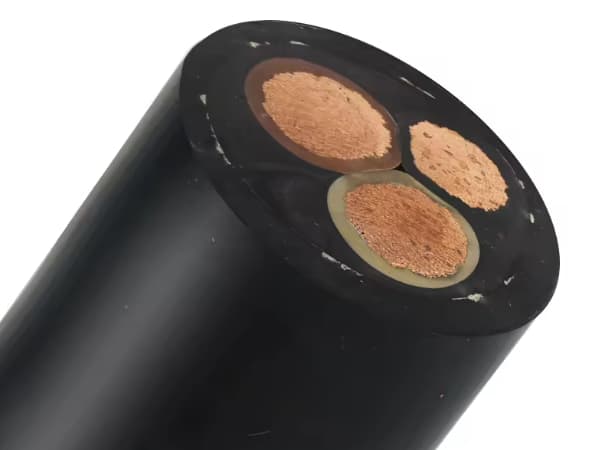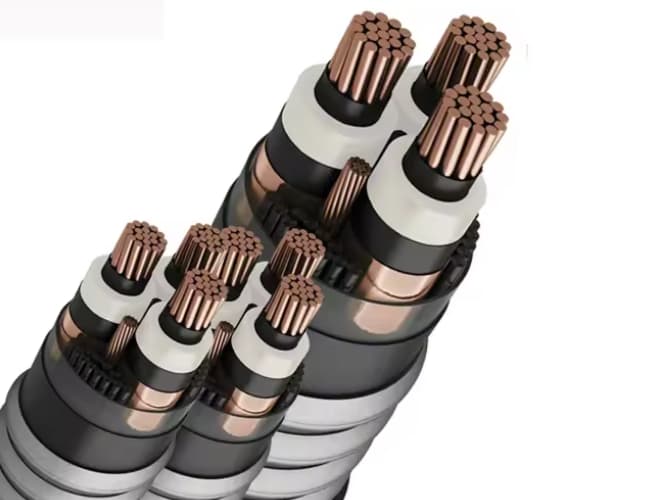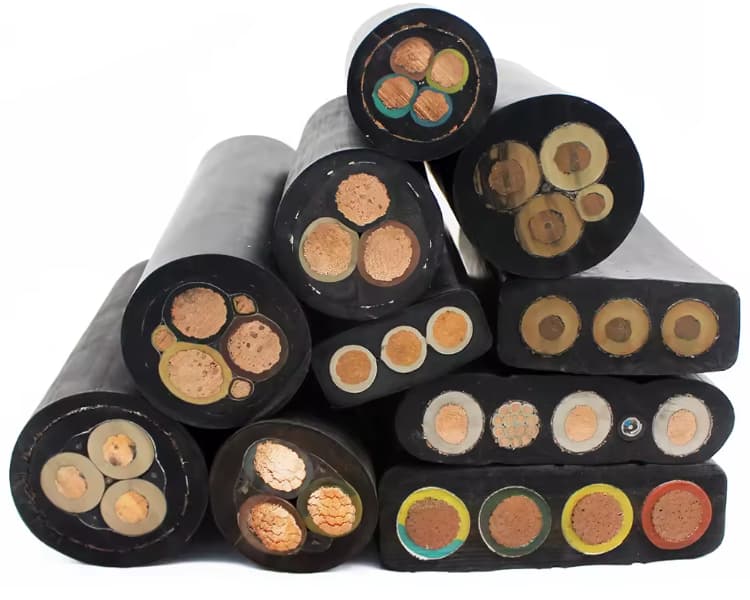
The demand for reliable electrical cables, flexible and strong has led to the increasing popularity of ethylene propylene rubber cables (EPR) in a wide range of industries. EPR cables are known for their excellent insulation properties, thermal stability and resistance to environmental challenges. This comprehensive guide explores everything you need to know about EPR cables, focusing on key issues such as EPR cable insulation, EPR rubber cable, the MV cable 105 15kV, Cape EPR XLPE, el cable EPR 15kV, el cable EPR CPE, the EPR PCP cable and the EPR Type C.
What is EPR cable?
EPR cable refers to cables that use ethylene propylene rubber (EPR) as the main insulating material. EPR is a synthetic elastomer with unique properties that make it ideal for use in environments that demand durability, electrical flexibility and reliability. EPR cables are often used in medium voltage applications (MT) and high voltage (AT), where performance under stress is essential.
EPR insulation properties
The main characteristic of EPR insulation is its ability to maintain electrical and mechanical integrity under a wide range of conditions.. Some key properties are
High dielectric strength: EPR offers excellent electrical insulation, making it suitable for medium and high voltage applications.
Thermal stability: EPR insulated cables can withstand high and low temperatures, which usually range between -40 °C y 90 °C, with some variants designed for even more extreme conditions.
Chemical and moisture resistance: EPR insulation is moisture resistant, to ozone and various chemicals, making it ideal for harsh environments.
Flexibility: The elastomeric nature of EPR makes it very flexible, which is beneficial during installation and operation in confined or dynamic environments.

EPR Cable Insulation vs. Other Insulations
EPR cable insulation stands out when compared to other types of insulation, such as cross-linked polyethylene (XLPE). Although Cabo EPR XLPE cables are both widely used, They serve different purposes depending on the demands of the application.
EPR insulation: Delivers superior flexibility and durability in environments where mechanical stress prevails, vibration or movement. EPR cables are excellent for use in mining, marine and industrial automation.
XLPE insulation: Known for their great thermal stability and chemical resistance, XLPE insulated cables are more rigid and are often preferred in applications that require a durable and stable solution for power transmission without the need for frequent bending.
Applications of EPR cables
EPR cables have diverse applications in multiple industries. Your flexibility, Durability and superior insulation properties make them suitable for use in areas where standard cables might fail. These are some of the main applications:
1. Medium Voltage Power Distribution (cable MV 105 15kV)
One of the most common uses of EPR insulated cables is medium voltage power distribution., especially in the form of MV cables 105 15kV. These cables are designed for use in electrical systems operating at voltages up to 15 kV, which are usually found in public service distribution networks, industrial plants and large-scale infrastructure projects. 15kV EPR cable is especially valued for its ability to withstand high voltage loads, while offering flexibility and protection against environmental risks.
2.Marine and underwater applications
In the marine and underwater sectors, cables are often exposed to moisture, to salt water and high pressure environments. EPR rubber cables are preferred for these applications due to their excellent moisture resistance., flexibility and ability to withstand harsh conditions. Its use ranges from power distribution on ships and oil platforms to submarine power cables for offshore energy platforms and renewable energy installations such as wind farms..
3.Mining industry
Mining environments are notoriously tough on equipment, and cables used in these environments must be able to withstand mechanical stress, abrasion and exposure to harsh chemicals. EPR insulated cables stand out in mining applications for their flexibility, durability and resistance to environmental challenges. They are usually used to power heavy machinery, transportation systems and underground mining operations, where conditions can be especially harsh.
4.Oil and gas industry
In the oil and gas sector, electrical cables are subjected to extreme temperatures, corrosive chemicals and fire risk. EPR CPE and EPR PCP cables are designed to withstand these demanding conditions. Cables used in this industry must be oil resistant, to chemicals and environmental hazards, making EPR insulated cables a reliable choice.
5.Industrial automation and robotics
EPR cables are frequently used in industrial automation systems due to their flexibility and resistance to high temperatures and mechanical stress.. These cables are usually found in automated machinery, robotics and other equipment in which frequent movements and bending occur. Type C EPR cable is often used in these environments due to its superior insulation and ability to withstand high voltage environments..

Types of EPR cables
There are several different types of EPR insulated cables., each designed for specific applications. Understanding the differences between these types can help you select the right cable for the job..
1.Cable EPR CPE
EPR CPE cables combine EPR insulation with a chlorinated polyethylene outer jacket (CPE). This combination provides excellent chemical resistance, oils and abrasion. These cables are commonly used in industries where the cables are exposed to aggressive substances., as in oil and gas refineries, chemical plants and heavy industrial environments.
2.Cable EPR PCP
EPR PCP cables use a combination of EPR insulation and a polychloroprene outer jacket (PCP), which is usually called neoprene. These cables are very resistant to oils, fats and weather conditions, making them suitable for use in industrial environments where they may be exposed to mechanical stresses and adverse environmental factors.
3.Type C EPR Cable
Type C EPR cable is designed for heavy duty applications requiring superior electrical insulation and mechanical protection. These cables are often used in mining, drilling and other industries where equipment is exposed to extreme conditions. Type C EPR cable is known for its ability to withstand high levels of tension, while maintaining electrical performance.
Advantages of EPR cables
EPR cables offer several advantages over other types of insulated cables., making them a popular choice for demanding applications. Some of the main advantages are
1.Flexibility and durability
The rubbery nature of EPR insulation provides greater flexibility than other, more rigid insulation materials., like XLPE or PVC. This makes EPR cables easier to install in tight spaces and more resistant to mechanical stress and bending during operation.
2.Thermal and chemical resistance
EPR cables are designed to withstand a wide range of temperatures, from extremely low to high, without compromising its performance. Besides, Their resistance to chemicals and humidity makes them ideal for use in environments where exposure to corrosive substances is common..
3.Superior electrical insulation
EPR has excellent dielectric properties, meaning it can provide high levels of electrical insulation even at high voltages. This makes EPR insulated cables suitable for medium and high voltage applications where electrical reliability is critical..
4.Fire resistance
EPR insulation is known for its fire retardant properties, an essential safety feature in many industrial and commercial environments. Fire-resistant cables can help prevent the spread of fire in the event of an electrical failure, improving overall security.
5.Longer useful life
Thanks to its resistance to environmental factors such as heat, humidity and chemicals, EPR cables typically have a longer lifespan than cables insulated with less durable materials. This reduces the need for frequent maintenance and replacement, which translates into costs
EPR Cable Conclusion
EPR cables are a versatile and reliable solution for a wide range of electrical applications, especially in environments where durability, flexibility and resistance to adverse conditions are essential. From MT cables 105 15 kV used in power distribution to EPR rubber cables designed for marine and mining applications, These cables offer superior insulation and protection in harsh environments.
By knowing the different types of EPR cables, like EPR CPE cables, PCP EPR cables and Type C EPR cables, Industries can ensure they are selecting the right cable for their specific needs. Whether in power distribution, industrial automation or hazardous environments, EPR insulated cables continue to play a vital role in ensuring safe and efficient electrical systems.
